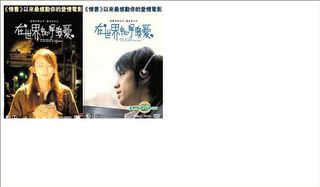
Sekai no chuushin de, ai wo sakebu
????????????
Crying out, in the Center of the World
When you die, does love die, too? That's the question at the heart of Crying Out Love in the Center of the World, the 2004 box office sensation directed by Isao Yukisada. Based on the bestselling romance by Kyoichi Katayama, the film stars Takao Osawa as Sakutaro Matsumoto, a brooding thirtysomething male engaged to the beautiful Ritsuko Fujimura (Kou Shibasaki). But the seeming normalcy of this happy couple's life is interrupted by an incident straight out of a Haruki Murakami novel. While packing up for a move, Sakutaro's fianc�e discovers a long forgotten cassette tape. After searching the local stores for a Walkman capable of playing the now obsolete technology, she finally listens to the cassette and hears a young girl's voice. Moved to tears by the tape's content, Ritsuko promptly walks out of Sakutaro's life, leaving him with nothing but a cryptic note. The incident eventually sparks Sakutaro's memory banks, plunging the man's thoughts backwards in time, some seventeen years ago. His current situation, it seems, has origins in the past.
The film then shifts perspective to 1986 and focuses on the budding romance between young "Saku" (now played by Mirai Moriyama) and Aki Hirose (Masumi Nagasawa), an intelligent "girl next door" type with a radiant smile and personality to match. Besides getting into a variety of adventures, the two eventually find themselves "dating" by recording messages for each other on cassette tape and exchanging them at school.
The narrative intercuts between the past and the present as we then follow the elder Sakutaro returning to his hometown, visiting old haunts, and eventually finding the cassettes Aki left for him. But it seems that Sakutaro isn't the only one who has returned. Ritsuko, too, seems to wander the same areas as her fianc�. But to what purpose? That question is tabled until the film's final act, but in the meantime, the audience is treated to a refreshingly well-drawn teenage love story, albeit, one that harbors a tragic secret.
It's not hard to understand why Crying Out Love in the Center of the World was such a box office smash. Although Takao Osawa and Kou Shibasaki are competent in the lead roles, the fate of the film really hangs on the performances of the two young actors, and they both pull through magnificently. Mirai Moriyama does a fine job as the young Saku, using his unique manga-like mug to great effect for scenes of comedy, romance, and tragedy and imbuing his character's journey from awkward teen to mature adult with a surprising sense of realism. Masami Nagasawa is a revelation as Aki Hirose, and a fine choice to play a character who so effectively changes her loved one's life. Able to convey intelligence, humor, and grace all at once, Nagasawa is a charming screen presence, able to change the tone of scene with little more than a smile. The romance presented here is of the chaste variety, and although some may question the believability of such a thing in the face of impending doom, the actors pull it off extraordinarily well. If anything, this movie is an old fashioned romance made relevant for a contemporary audience.
Ultimately, Crying Out Love in the Center of the World is a film that celebrates the bloom of youth and the thrill of first love. Even so, the film isn't just about nostalgia, but about finding peace and starting over. In a world where real closure is hard - if not impossible - to find, the bittersweet Crying Out Love in the Center of the World provides it in spades. If liking this movie makes me a sentimental fool, so be it.

0 Comments:
Post a Comment
<< Home